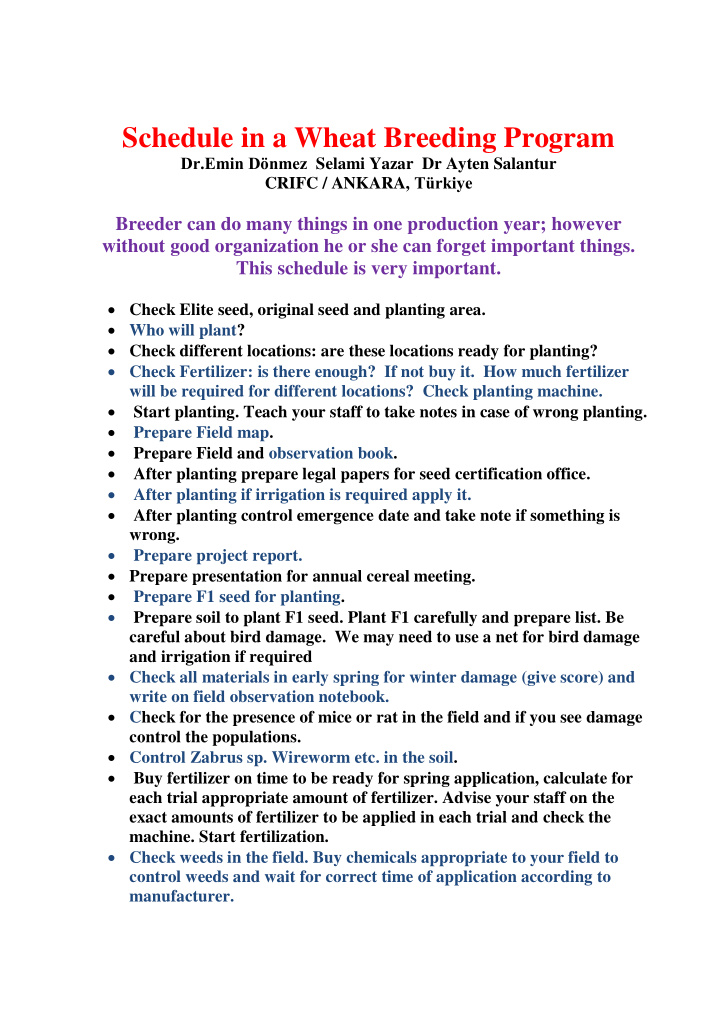



Schedule in a Wheat Breeding Program Dr.Emin Dönmez Selami Yazar Dr Ayten Salantur CRIFC / ANKARA, Türkiye Breeder can do many things in one production year; however without good organization he or she can forget important things. This schedule is very important. Check Elite seed, original seed and planting area. Who will plant? Check different locations: are these locations ready for planting? Check Fertilizer: is there enough? If not buy it. How much fertilizer will be required for different locations? Check planting machine. Start planting. Teach your staff to take notes in case of wrong planting. Prepare Field map. Prepare Field and observation book. After planting prepare legal papers for seed certification office. After planting if irrigation is required apply it. After planting control emergence date and take note if something is wrong. Prepare project report. Prepare presentation for annual cereal meeting. Prepare F1 seed for planting. Prepare soil to plant F1 seed. Plant F1 carefully and prepare list. Be careful about bird damage. We may need to use a net for bird damage and irrigation if required Check all materials in early spring for winter damage (give score) and write on field observation notebook. Check for the presence of mice or rat in the field and if you see damage control the populations. Control Zabrus sp. Wireworm etc. in the soil. Buy fertilizer on time to be ready for spring application, calculate for each trial appropriate amount of fertilizer. Advise your staff on the exact amounts of fertilizer to be applied in each trial and check the machine. Start fertilization. Check weeds in the field. Buy chemicals appropriate to your field to control weeds and wait for correct time of application according to manufacturer.
Clean/adjust street and plots in the field according to desired plot size, cut plots if required (Make it proper size 1.2X5 ) Prepare irrigation system if you have irrigated trial. And do it. Check all locations and apply fertilizer. Chemical control of weeds if required and observations. If you have late planting during spring time give legal documentation to certification organization Control bird damage in all material specially F1 and crossing block. Use tent/net or other equipment. Take note from all materials (e.g. days to heading and flowering) Check equipment for crossing and make your crossing program. Show how to do a cross to your staff and start crossing Take disease notes from natural conditions and disease inoculated plots for leaf rust, stem rust, tilletia and others. Write these on the observation note book. Check different type or off type plant on the yield trial and seed production. Roging different type plant (1. control) Take notes for plant environment. Look for diseased F 3 ’ and select resistant plants using appropriate tags or labels. Take stress notes in each trial (Drought, Heat, water logging) Check for off- type plant again on the yield trial and seed production. Roging different type plant (2. control) Take notes on maturity date (Milky, Dough, Full) Check different type or off type plant on the yield trial and seed production. Roging different type plant (3. control) Label F5’ for selection. Check different locations. Take notes on observations and if there is any kind of damage. Check machine and other equipment for harvest. In F 3 ’ take spike previously selected for disease resistance and agronomic performance. Send remaining grain to Quality lab. Harvest selected F5’ (One row 2 m.) Harvest observation nurseries (materials from other country or other parts of country to re-check) Collection of dried Crossing materials with hand -take notes. Harvest Yield trial. Harvest yield trial and other materials in all locations. Select plan for single spike in elite seed production for next year. (Separate planting plan for spike)
Harvest Elite seed of varieties. Clean harvest machine properly between 2 varieties or candidate for variety. Harvest of spike or plant and check seed, discard unsuitable material. Harvest all locations. Clean harvested yield trial seed and take notes on weight yield. Sending clean grain material for Quality test. Statistical analysis of yield trial. Select (ACORDING TO YIELD, DISEASE, QUALITY AND AGRONOMIC TRAITS) material and use these for next generation. Prepare selected and harvested spike for planting. Prepare seed of Crossing block, observation nursery, Segregating materials, preliminary yield trial, yield trial and regional yield trial materials for planting (don’t forget Chemical treatment). Send seed of candidate lines to certification organization. (Don’t forget to send plant chart with plant type …….) Check elite seed visually for alien material and species than arrange appointment from certification organization to take a sample for certification. Check planting machine, fertilizer, field for planting. Start planting??? Look in the literature for new equipment, materials, and methodology useful to your program. Check your stock material. Check your program: which part is weak? Can you do anything to change it? If you cannot feel happy or successful, look for another Job!!!!!!!!
Recommend
More recommend